Political Motive in the Case
by Sachi Sri Kantha, November 1, 2017
Testimony of Head Constable Lakshmanan
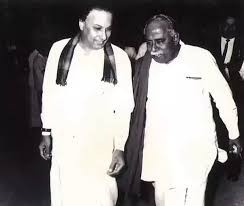
MGR and Anna
One of the vital evidence in the MGR shooting case, which links the political angle of the case was a ‘letter’ or ‘report’ handed by M.R. Radha (prior to his admission to the Royapettah hospital) to the head constable Lakshmanan, when the latter accompanied him. The caption written in that document written in Tamil ‘Ennudaiya Mudivu’ (translated into English, as either ‘My decision’ or ‘My end’). Chapter 19 of Sudangan’s book provides some details of the testimony of Lakshmanan. Excerpts in English follows:
To the questions of public prosecutor, Lakshmanan responded as follows:
“I work as the head constable of Saithapettai police station, since June 18, 1966. I was on duty at the station on January 12, 1967, from 4:45 pm. At 5:45 pm, sub inspector Durai called me and instructed ‘M.R. Radha is in the car with blood wounds. Take him to Royapettah hospital. I was seated in the front seat, next to the driver. Radha was seated in the back seat, adjacent to watchman Muthu. I looked at Radha. He was wearing silk shirt, veshti and shawl. There were blood stains in them. His face also had blood stain….While Muthu and I assisted Radha to be seated in the stretcher, he gave me a paper from his pocket saying ‘Keep this paper with you.’ Then, Radha was taken into the hospital. When I opened that paper, ‘My decision’ was written in it. There was blood stain in the border of that document. It consisted of four pages. First three pages were in carbon paper. Final page was written in ink. In each of the pages, there was signature M.R. Radha in English. When I read it, there were details on income tax, meeting, gift of knife, gift of life – all related to politics. I wrote initial and date in each of these and kept in my pocket. (Witness did identify this document in the Court.)
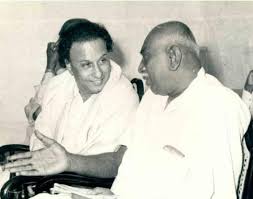
MGR and Kamaraj
When asked by the prosecution, to read aloud the contents of this letter/document, Lakshmanan complied. Some of the mentioned details in it were,
‘Due to other involvements such as income tax troubles, I haven’t studied the recent political developments for the past six months. I didn’t have time to appreciate the thoughts of the Dravidar Kazhagam. I was invited by Mr. D.M. Chanmugam, the President of the Chennai Dravidar Kazhagam branch and other friends for a meeting to be held on January 8, 1967, in which Periyar [E.V. Ramasamy Naicker] will participate. I couldn’t reject this invitation. It was poorly attended. Only four good journalists were there. None of the speakers expressed their own views. They talked about how the print media covered politics. Those who talked then were, 1. Anaimuthu, 2. Tiruvarur Thangarasu, 3. Thirukural Munusami, 4. Poet Balasundaram, 5. Tiruchi friend, 6. Veeramani…. They mentioned about the opinion of Rajagopalachari. In a propaganda meeting, due to political jealousy, he had emphasized ‘Destroy Congress. Then, let’s see what happen. Even if there is anarchy, I’ll take care of it.’ Rajaji had forcefully stated. With the aid of those who had separated from us as bucket carriers, he says that!…They create a coalition with the votes of rowdies and criminals. They attempt to defeat and destroy Congress. Northerners are also planning to kill Kamaraj.
Even before Northerners, these mountebanks from the South had plotted to kill him [Kamaraj]. I had written about this in Nathiham paper, without mentioning names. Now, if this work is done here by these mountebanks, blame could be transferred to the Northerners. I had mentioned this many months ago.
Kamaraj did escape the assassination plot of Aryans, one called as Munivan, and chameleonic Congress men. Affected by this, Periyar had come forward to offer gift of knife to those who oppose Aryanism. I spoke about gift of life, at the conference. When I was leaving at the end of the conference, some sarcastically joked, ‘He talks about gift of life; let him do that first.’ I assert that rather than destroying Aryam first, lets first destroy some who aid and abet Aryam sneakily.
We need a movement in this election, to lead gift of life, in this country. I’m willing to lead it. Fasting to death is not gift of life. Burning self with petrol is not gift of life. That’s sheer rowdyism. Taking one or two lives of plotters. This is the principle of gift of life. I will do. You all should do. Will you do?’
Lakshmanan continued his testimony further. At 8:45 pm, Cingleput police superintendent inquired about whether Radha had given any ‘paper’. I handed this item to him. Excerpts from his answers to the cross examination by defense attorney Vanamamalai were as follows:
Attorney: How many pockets were there in Radha’s shirt?
Lakshmanan: I saw only one.
Attorney: Roughly, what could be the size of the packet?
Lakshmanan: Like that of a one in regular shirt.
Attorney: Could it be 4 inches?
Lakshmanan: Probably smaller than that.
Attorney: You mentioned that he had blood stains. Did you think that he was in a serious condition?
Lakshmanan: Yes, I thought so.
Attorney: On you way to hospital, did you ask what happened?
Lakshmanan: No.
Attorney: Why?
Lakshmanan: He was not in a speaking condition.
Attorney: In the police station, did you read the ‘report’ given by M.R. Radha?
Lakshmanan: I read quickly in 5 minutes.
Attorney: When did you record it in the notebook?
Lakshmanan: At the time recorded in the notebook.
Attorney: You mentioned that the paper given to you, was folded. How many folds were there?
Lakshmanan: It was folded three times.
Attorney: I mention that the paper given to you by Radha, is false. Is it so?
Lakshmanan: No. He did give it to me.
Attorney: Is it true that you have been forced to say false evidence in this case?
Lakshmanan: No.
Attorney: I assert that this case is ‘decorated’ and what is purported to be written by Radha has been politically ‘decorated’. Is it true?
Lakshmanan: No.
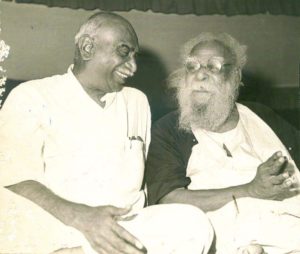
Kamaraj and E.V. Ramasamy Periyar
In his evidence, Radha had denied that he couldn’t remember handing the ‘My decision’ document to the head constable on the day he was admitted to the hospital. He also insisted that he couldn’t have written about income tax, gift of knife, gift of life and politics in that document, because he was illiterate. Magistrate Court judge S. Kuppusamy, in his ruling offered at the end of May 1967 had indicated that accused had offered conflicting details about the events and his statement was unreliable. That Kamaraj’s residence in New Delhi was attacked by anti-cow slaughter demonstrators (tagged as extremist Hindu Mobs) on November 7, 1966, is a fact. It happened because he held the presidency of the Indian National Congress at that time. But, Radha’s effort to link what happened in New Delhi to the opposition of Congress Party in by the DMK-led alliance in Tamil Nadu was misdirected.
M. Balasanmugam (a clerk at the Police Commissioner Office) gave evidence that M.R. Radha was granted gun possessing license on November 26, 1964. With this license, 100 bullets could be purchased. Radha’s gun was bought from R.R. Chandran, Chennai 17, for 2,200 rupees. This license expired on December 31, 1965 and was not renewed. MGR also had a valid gun possessing license, issued on October 18, 1956. His license had an expiry date until December 31, 1967. The single bullet taken from MGR’s neck and the two bullets taken from Radha’s skull were identified in the court by Saithapet submagistrate court’s clerk M. Kasinathan and his deputy Santhanakrishnan. A forensic expert had certified that all three bullets were released from the same revolver. The blood stain of Radha spilled at the carpet of MGR’s house was also presented at the court and identified by the forensic chemist.
Verdict of Sessions Court
The Sessions Court verdict was delivered on November 4, 1967 by Justice Lakshmanan. Summarizing 262 page verdict, Lakshmanan offered the following synopsis.
“This is an unusual case. The victim in this case M.G. Ramachandran is a member of DMK party, former member of Madras Legislative Council, and now an elected representative of DMK for St. Thomas Mount constituency. Accused M.R. Radha , though not a member of DK party is an active supporter of E.V. Ramasamy Naicker. In the last election, DK supported Congress Party. Both MGR and Radha are movie and stage actors. Lately, Radha’s opportunities in the movie world had slided.
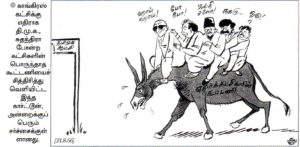
Ananda Vikatan cartoon 1966 Aug 21 by Sridar
Prosecution had provided three reasons for Radha committing this crime. (1) professional jealousy, (2) political reason, and (3) economical difficulty. Witnesses had provided proof to the professional jealousy component between Radha and MGR. When the shooting incident occurred, Radha had a debt of 700,000 rupees. Prosecution had proved that he was desolated due to this factor. If one assumes that he had a monthly income of 50,000 rupees as he claimed, this amount of debt couldn’t have accumulated. This could be one reason for his attempted suicide.
Let’s view the professional jealousy component. Though MGR had reached 50 years, he still possess influence to act as a hero in many movies. Witnesses had asserted this fact. Simultaneously, Radha’s market had turned ‘dull’. The fact that he had become a debtor had been indicated by witnesses. As such, the professional jealousy cannot be excluded. I do accept this argument. In a case where circumstances and related witnesses have to be depended, motive for the committed crime is a vital component. If existence of motive had been disproved, this could have favored Radha’s position. Nevertheless, there is an eyewitness for this incident. Thus, with the existence of eye witness evidence, the necessity to prove the relevance of motive doesn’t arise.”
The verdict delivered for accused Radha was, (1) 7 years rigorous imprisonment for attempting to shoot MGR; (2) 6 month imprisonment for attempting to commit suicide; (3) 2 years rigorous imprisonment for keeping an unlicensed gun; (4) 2 years rigorous imprisonment for not handing the gun used for shooting to the police; (5) 3 years rigorous imprisonment for using the gun unlawfully. All sentences are inclusive for simultaneous punishment period.
Reports in the New York Times, 1966-67
A special report which appeared under the byline of Joseph Lelyveld, dated Feb.10, 1967, in the New York Times did predict marginally that this shooting incident involving MGR may influence the February general election results. The sub-caption stated, “Opposition group has edge in Madras because Actor supporting it was shot”. For its relevance and for historical record, I provide this special report in entirety below. This was the first time that MGR’s name (in association with those of his illustrious movie contemporaries, Sivaji Ganesan, Padmini and M.R. Radha) appeared in the New York Times. Please note that the literal translation of Tamil movie titles into English, except two (i.e., ‘Ali Baba and the Forty Thieves’, an MGR starrer; and ‘The Unexpected’, a Padmini starrer.) in this report leaves much to be desired. Sivaji Ganesan movies mentioned, ‘Almighty Godess’ is Parasakthi (1952) and ‘Forgive Sin’ is Pava Mannippu (1961). MGR’s movie ‘The Gypsy Kind’ is Nadodi (1966).
“A touch of California has entered the election campaign in Madras, with the major parties vying to associate themselves with movie stars. Sivaji Ganesan, the star of such Tamil language hits as ‘Almighty Goddess’ and ‘Forgive Sin’, has been making regular appearances at rallies of the governing Congress party.
Sivaji Ganesan, the star of such Tamil-language hits as ‘Almighty Godess’ and ‘Forgive Sin’, has been making regular appearances at rallies of the governing Congress party. Film lovers here call him ‘the Tamil Marlon Brando’. Also appearing for the Congress is Padmini, a popular actress and dancer who gave a memorable performance, according to those who remember it, in ‘The Unexpected’. ‘Padmini is a very good draw for the Congress’, a political observer said. ‘Everyone wants to see if she is as beautiful in the flesh as she is in the movies.’ Is she? ‘She is!’ he replied emphatically. Do her political views have any influence? ‘Of course not.’
Sivaji and Padmini notwithstanding, the Congress Party is lagging far behind its main opposition, the Dravidian Progressive Federation – usually known as the DMK for its Tamil name, Dravida Munnetra Kazhagham, in its efforts to capture some of the luster of the film world.
For the federation has M.G. Ramachandran, ‘the Tamil Errol Flynn’, famed for his roles in the ‘The Gypsy Kind’ and ‘Alibaba and the Forty Thieves’. In what was certainly the major event of the campaign in Madras, he was nearly lost to the federation. On Jan. 12 he was shot in the neck and critically wounded by another film star M.R Radha, who had long been typed as a villain. Mr. Radha then shot himself in the neck in an unsuccessful suicide attempt.
Mr. Ramachandran is always referred to in the Tamil press as ‘Makkal Thilagam’, which means ‘idol of the masses’. So angry was the reaction to the attempt on his life that policemen had to use tear gas to disperse the crowds assembled outside his hospital. The political Ramachandran was not just another film star off at rallies; he was a candidate himself, nominated by the Dravidian Progressive Federation for the state Assembly from Chingleput District.
There was an immediate suspicion – probably unfounded – that the shooting had political motives. Mr. Radha was prominent in the Dravida Kazhagam (Dravidian Federation), a small Tamil nationalist group that led to the Progressive Federation many years ago but now is backing the Congress Party. Political observers of all factions agree that the federation has shown restraint and responsibility in not trying to smear the Congress Party with the shooting.
Though Mr. Ramachandran is likely to be in the hospital for a month more at least, his candidacy in the Feb. 15-21 election has not been withdrawn, and he is certain to win. The bullet is still lodged in his neck and his doctors have ordered him to refrain from talking, but he is very much in the campaign. A photograph of him in the hospital, a heavy cast around his neck, has been reproduced by the thousands.
Election propaganda appears everywhere in Madras. Party flags – orange, white and green for Congress, black and red for the federation – fly from stores, cars, lampposts, telephone wires and bicycle handlebars. They even fly on tall bamboo standards from the sqalid mud and thatch hovels of the slums, turning them into absurd parodies of the tents of some great medieval army.
With the excitement of the campaign and the shooting, the latest Ramachandran movie has become a stupendous success. What makes it irresistible is the casting of the real-life assailant in the villain’s role.
Movies reach far more Indians than any other means of communication. In Madras last year 150 full-length features were made – more than in any other Indian city – and 65 were in Tamil.”
What is noteworthy is that, two days previously, same Joseph Lelyveld had reported that “There are no polls and few other guides to popular sentiments, but it is generally thought that the Congress Party will run strong in rural areas while the federation [i.e., DMK alliance] will dominate the cities,” and predicted that Congress Party is expected to win (a) about 130 Assembly seats out of 234 seats and 25 seats among 39 parliamentary seats.
Two reports that appeared in the New York Times in 1966, authored by Anthony Lukas on Tamil Nadu politics, focusing on the activities of the Congress Party leader Kumarasami Kamaraj (‘Political Python of India’) and that of his long term foe Swatantra Party leader, Chakravarthi Rajagopalachari (aka Rajaji) offers context to the political turmoil which engulfed the February 1967 General election. In July 1966, Rajaji could only hint that a Congress defeat is ‘not unlikely’; according to Lukas, “Other observers concede that it will be a close fight this time but most believe that the Congress will scrape by.” In February 1966 (a year before the 1967 election), Kamaraj was portrayed as the ever-powerful dominator (or ‘King-Maker’) of the Congress Party in the post-Nehru era. Lukas had noted, ‘His genius lies in dealing with men as they are, not in changing them, and this ability is based on a realistic assessment of human nature…Blessed with a prodigious memory, Kamaraj plays on each man’s weakest point, and often does it so neatly that the subject hardly realizes what is happening.’ Quoting an anonymous long term Kamaraj watcher, Lukas had written, ‘He does not conquer his enemies. He believes in crushing them as smoothly and slickly as possible, all the time making them feel better and better. He is a veritable political python.’
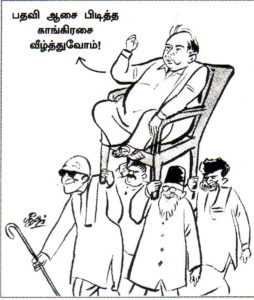
Ananda Vikatan cartoon circa, pre- Feb 1967, by Sridar
Similar sentiments on Kamaraj had been openly expressed by poet Kannadasan in his autobigraphy too. Kannadsasan had written, “ He [i.e., Kannadasan in third person singular] did compare Kamaraj and Anna. Anna would excuse and forgive a good for nothing back stabber. If Kamaraj realized that even his slave who was devoted to him raises above, he will suppress him. Or he will pit him against another guy. This was the reason for Anna’s successes and Kamaraj’s defeats… In the conflict he had with Rajaji, Kamaraj disposed many of his colleagues. He considered this as a sort of diplomacy. He used this tactic against the big guys and small guys. Eventually, this attitude dug a hole for his popularity dip.’
From the New York Times reports in 1966, it becomes evident that though disadvantaged in literacy and language skills, Kamaraj, the then boss of Congress Party was a shrewd political operator who was hardly underestimated by his political foes Rajaji and Annadurai. Though the movie star glamor of DMK party had been highlighted by analysts, when it comes to elections, even Congress Party also had its own roster of movie stars cannot be discounted. Apart from mentioning Sivaji Ganesan and Padmini, Lelyveld missed out on another popular ‘face’ used in the Congress party platforms in 1967 – that of Carnatic Music diva and veteran actress K.B. Sundarambal (1908-1980). She had been used by Congress Party politicians in the pre-independent Indian propaganda campaigns.
Cartoons depicting the Feb. 1967 Election Campaign
Two cartoons that appeared in the Ananda Vikatan weekly depicted the tussle between the Congress Party and the anti-Congress alliance of DMK, Swatantra Party, Communist Party of India (Marxist) and Indian Union Muslim League. A pro-Congress cartoon of August 21, 1966 created some controversy, in which the anti-Congress alliance leaders were drawn derisively, traveling in a donkey towards the sign post showing ‘Tamil Nadu government’. The five leaders seated in the donkey were taunting it with different ‘slogans’ using different words (indicating the policy differences among them, ranging from political ‘right’ to ‘left’ and ethnic groupings). A subsequent cartoon, somewhat to placate the ruffled sentiments, showed Anna (the leader of DMK) being carried in a chair, by other four leaders, with words from Anna ‘We’ll defeat the ruling-crazy Congress’. It also indicated that Anna will be the alternate leader of the anti-Congress alliance.
Though in his autobiography, MGR had emphatically refrained from mentioning any political motive for Radha’s shooting attempt, Vidwan V. Lakshmanan (MGR’s assistant and ghost writer of this autobiography) in his own biography on MGR (published while MGR was alive) had specifically attributed a political motive to the opponents of DMK party’s exceptional growth in early 1960s. Lakshmanan had claimed that Radha was trapped as an executor of the killing plot. The plotters believed that eliminating MGR would facilitate an electoral victory to their party.
Overall, it becomes evident that the shooting incident of MGR precipitated by the irrational action of Radha on January 12, 1967 gathered excessive amount of sympathy votes for MGR – the movie hero cum philanthropist, on behalf of the DMK alliance to dislodge the Congress Party from power in Tamil Nadu.
Cited Sources
Poet Kannadasan: Manavaasam (autobiography, vol.2), Vanathi Pathipagam, Chennai, 5th ed., 1991, pp. 127-129 (serialized in Kalki magazine, from 1961 to 1976).
Vidwan V. Lakshmanan: Makkal Thilagam MGR, Vanathi Pathippakam, Chennai, 4th ed., 2002 (originally published in 1985).
Lelyveld, J.: Front battles Congress Party rule in Madras. New York Times, Feb. 8, 1967.
Lelyveld, J: Movie idols star in Indian election campaign. New York Times, Feb.10, 1967.
Lukas, J.A. ‘Political Python of India’. New York Times, Feb. 20, 1966.
Lukas, J.A. ‘Rajaji’, 87, seeks political victory in Madras. New York Times, July 10, 1966.
Malaimalar com. Transcripts of the MGR shooting case, published between May 31, 2012 and June 15, 2012, in Tamil. ( http://cinema.malaimalar.com)
MGR: Naan Yean Piranthen, part 1, chapter 45, Kannadhasan Pathippagam, Chennai, 2014, pp. 568-571.
- Srivatsan: Radha pleaded innocence; was found guilty. The Hindu (Chennai), Dec.24, 2012.
Sudhangan: MGR Kolai Vazhakku – Suttachu Suttachu, Kizhakku Pathippagam, Chennai, 2005.